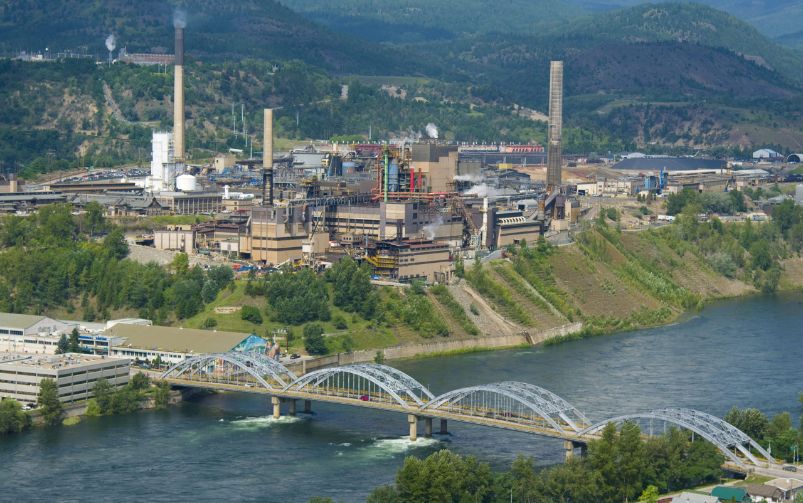Algoma Steel Group is receiving a $500 million loan from the federal and Ontario governments to support its transition to electric arc furnace steelmaking as it continues to navigate challenges from the U.S. trade war. Courtesy of Algoma Steel Group.
Welcome back to your weekly mining news recap, where we catch you up on some of the news you may have missed. This week’s headlines include Imperial Oil cutting 20 per cent of its workforce, McEwen Copper’s Los Azules project obtaining tax benefits from Argentina’s government and Nippon Steel buying a stake in the Kamistiatusset iron ore project in Newfoundland and Labrador.
Barrick Mining’s Mark Bristow has handed in his resignation letter, after serving seven years as president and CEO. Bristow’s tenure has recently been clouded by disputes with Mali’s military government over Barrick’s Loulo-Gounkoto gold complex. Operations at the complex ceased in January and the Malian government took control of the mine in June. Mark Hill, a 19-year veteran at Barrick, has been named interim president and CEO while the company searches for a permanent replacement.
Newmont will also be getting a new CEO, after Tom Palmer announced his retirement from the role after a decade, Reuters reported. Palmer will make room for his replacement Natascha Viljoen, who joined Newmont in 2023 as chief operating officer, on Dec. 31. He will continue as a strategic adviser until his official retirement in March.
Algoma Steel Group is pivoting to electric arc furnace operations after securing a $500 million loan package from the federal and Ontario governments, amid the ongoing tariff war with the United States, The Globe and Mail reported. The company will shut its blast furnace operations earlier than planned and accelerate the rollout of electric arc furnaces. This transition is expected to help lower costs, increase production flexibility and help offset the loss of access to the U.S. steel market, which once accounted for up to 60 per cent of Algoma’s sales.
The Canadian Mining Hall of Fame has announced its 2026 inductees. David Harquail, Don Lindsay, Catherine McLeod-Seltzer and Gordon Garfield Morrison will be recognized at a ceremony in Toronto on Jan. 8, 2026, for their contributions to Canada’s mineral exploration and mining sector, as well their influence in the global industry.
Imperial Oil is cutting about 900 jobs—roughly 20 per cent of its workforce—by the end of 2027 as part of a company-wide restructuring plan, the Financial Post reported. Most of the job cuts will be in Calgary, along with some roles offshored outside of Canada, as Imperial consolidates operations with its parent company Exxon Mobil Corp. Imperial expects the plan to cost $330 million upfront but to generate about $150 million in annual savings by 2028.
The environmental licence for Dundee Precious Metals’ US$419 million Loma Larga gold project in Ecuador has been suspended following mass protests over concerns that it threatens wetlands and regional water reserves, Business Intelligence for B.C. reported. The project, located near the El Cajas Massif biosphere reserve, has long faced opposition from Indigenous groups, though Dundee maintains that its environmental management plan meets strict environmental standards. Critics have also accused Ecuador President Daniel Noboa of conflicts of interest tied to other Canadian-owned precious metal projects in the country.
McEwen Copper’s US$2.7 billion Los Azules copper project in San Juan, Argentina, has secured tax benefits under the country’s Large Investment Incentive Regime (RIGI), Mining Technology reported. The RIGI offers benefits such as a lower corporate tax rate at 25 per cent, a 50 per cent reduced dividend withholding tax and streamlined customs and foreign exchange procedures. McEwen plans to release a feasibility study this month and aims to start producing copper cathodes at Los Azules by 2029.
Japan’s Nippon Steel is acquiring a 30 per cent stake in the Kamistiatusset (Kami) iron ore project in Newfoundland and Labrador, creating the new joint venture—Kami Iron Mine Partnership—with Australia’s Champion Iron and Japan’s Sojitz, Mining Technology reported. Nippon has paid $42 million of the total $150 million consideration through its subsidiary NS Canadian Resources. The remaining $108 million is contingent on a feasibility study the partnership is advancing. The Kami project’s high-grade iron ore is used for producing direct reduced iron.
The U.S. government is taking a five per cent stake in Lithium Americas, along with an additional five per cent stake in the miner’s Thacker Pass joint venture with General Motors in Nevada, CBC reported. Considered a key asset in reducing the United States’ reliance on lithium from abroad, Thacker Pass is expected to produce 40,000 tonnes of battery-grade lithium carbonate annually in its first phase—enough to supply 800,000 electric vehicles.
A new mining method, gravity-assisted bitumen extraction (GABE), is being piloted to recover bitumen from the most difficult to mine depths of Alberta’s oil sands deposits, Lynn Greiner reported for CIM Magazine. Developed by Drift Resource Technologies, GABE combines directional drilling, hot-water separation and paste backfill. Each process is proven individually, and the pilot test this year aims to show how they can work together in the field.
Managing the accumulation of water in Alberta’s oil sands tailings ponds remains a major environmental challenge since regulations do not currently allow the release of treated mine water, Ailbhe Goodbody reported for CIM Magazine. Alberta’s Ministry of Environment and Protected Areas formed the Oil Sands Mine Water Steering Committee in 2024 to evaluate solutions. In June, the committee released its first five recommendations, focusing on improving water-use efficiencies, updating policies encouraging the sharing of water resources, developing new measurement standards and reducing water accumulation at mine sites.
That’s all for this week. If you’ve got feedback, you can always reach us at editor@cim.org. If you’ve got something to add, why not join the conversation on our Facebook, Twitter, LinkedIn or Instagram pages?




